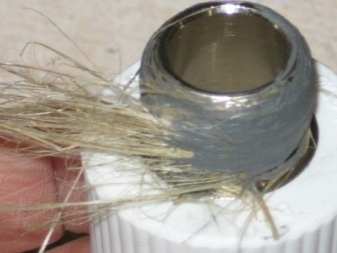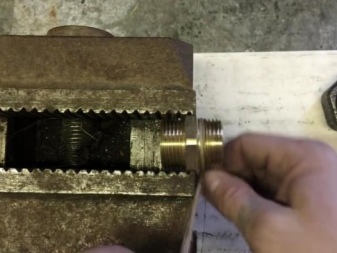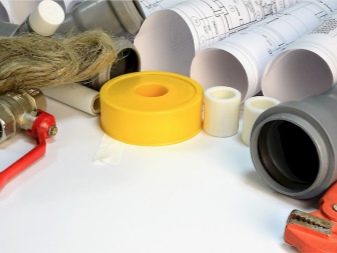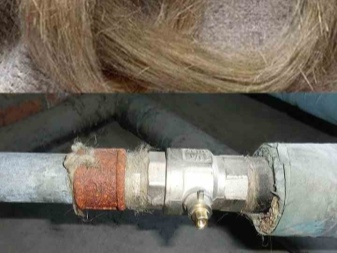How to properly wind tow on a thread?

The most demanded and popular sealant is tow. Low cost, availability and efficiency distinguish this reel from analogs. Anyone can make a seal with tow, even a person without experience in plumbing. Oakum is good for temporary connections and those that are in plain sight. Any leak can be repaired in just a couple of minutes.


Preparation
Paired with sanitary flax, paste is used. It makes the connection more reliable and durable. Simple tow can withstand temperatures up to 70 ° C. Higher quality material in combination with additional sealing increases the indicator to 120-140 ° C. In this case, tow can be wound even on the threaded connection of the heating pipe.
Before starting work, you should prepare the thread and determine the required amount of flax. The fitting should be screwed onto the pipe without winding. This will allow you to estimate the free space and understand how much tow will be needed. Such manipulation will take only a couple of seconds, but will greatly simplify further work.


When factory cut, the threads are often even and smooth. In this case, the tow will not hold well, so it is necessary to apply notches to the curls. The process is quite simple, you can use a wrench, a triangle or just a pair of pliers. A shallow cut should be made across the thread. As a result, the tow will cling to the threads and will not slip off during operation.
It is important to make the notch too deep. Simple preparation will allow the tow to be wound as efficiently as possible, and this affects the reliability of the seal. The tow can be wound on a new pipe or one that has begun to leak.
The method of preparation does not change from this, but the process itself depends on some nuances.


Step-by-step instruction
Quite often, the tow is wound on a new thread. You can make a tap or pipe sealing. Many modern manufacturers make fittings already with notches for tow, which greatly simplifies preparatory work. Otherwise, you will have to make them yourself so that the flax does not roll into a ball. For proper threading, follow the instructions.
-
Separate one strand from a whole skein of tow. In this case, you should take the optimal amount of fiber. The winding should not be too thin or tight. The optimal thickness will be 1-2 matches. If there are lumps or fine pile in the tow strand, then you should get rid of them before using.
-
The overlay itself can be done in several ways. Twist the tow into a bundle or weave a loose braid, and then lay it on the thread. You can just put the material as it is, loose.
-
At this stage, additional materials are applied. You can initially lubricate the threads, close the layer of tow, then reapply from above. Sometimes sanitary flax itself is impregnated with an additional agent to improve its properties. Both options are valid and interchangeable.
-
Tow can be wound along the thread or in the opposite direction. Doesn't matter. Pinch the end outside the thread with your fingers and turn it crosswise. This will lock the material in place.
-
Tightly, without gaps, wind the tow on the futorki.
-
Plumbing paste or similar material to improve the seal. For this, the composition is applied with rotating movements over the flax.
-
Take the other end of the tow slightly to the side, glue it near the edge of the thread using the same sealant.
-
Before twisting, make sure that the pipe hole is not clogged with sanitary flax. In this case, twist should be done with moderate effort. If the nut moves too quickly and easily, more tow should be wound.



The winding for water and for heating is slightly different. In the latter case, you can make it a little weaker. When heated, the metal will expand and fill the space. Excessive rewinding will result in damage.
It happens that it is necessary to seal an ecoplastic product. The material may burst, so proceed with caution. The tow should be spread evenly. A paste is applied on top, and then the fittings can be twisted. In this case, it should be done half a turn less than when connecting without tow.


In the case of plastic pipes, it is better to give preference to investment paste over sealant. Such a composition shows itself much better. If the parts are too tight when twisting, then you should immediately disassemble the structure and reduce the amount of tow. It is not necessary to tighten the fittings too much, otherwise the plastic may simply burst.
It happens that you have to work with old pipes and connections. Usually the cause is a sudden leak or any other defect that is found during inspection of the thread. Fitting mom should be cleaned of accumulated debris. It is convenient to do this with a sharp knife.
All contents of the second fitting must also be cleaned out. It is also important to cut off the remnants of the old winding and sealant. You can clean the threads to a shine with a wire brush. It will help remove all the dirt and rust in hard-to-reach turns.



Recommendations
It is not difficult to use tow, but there are some nuances when working with different materials. If an iron pipe and a steel coupling are used, then the excess flax will simply crawl out of the fitting. This is due to the power. But brass connections, especially modern ones, will simply burst from too high pressure.
If you make the winding too weak, then very quickly you will have to face a leak. An excess of tow always leads to more serious consequences. At elevated temperatures, the winding may burst. As a result, you will have to make a complete replacement.
After laying the tow, it is necessary to lubricate it with a specialized paste or its analogue. The product is always applied in a circular motion. It is important to act as carefully as possible so that the sealant does not get inside the pipe or outside the tow. Sometimes you can grease the thread itself with paste. In this case, the tow will stick to the material and will not slip.


With high-quality winding, after twisting, the details of the sanitary flax are not visible. If the tow is still noticeable, then there is too much of it, and the material pushes it out. In this case, be sure to unwind everything and reduce the number of fibers. When twisting, you will have to make some efforts, but not too much. Otherwise, there is a great risk of damage to the fasteners.
Tow cannot be used on gas connections. The material is organic and will degrade rather quickly. The same applies to silicone, which should also be excluded in this case. Flax is used only for water. The sealant works well in water, taps and heating connections.


However, with hot pipes everything is not so simple. The paste should be applied not only to the tow, but also to the pipe. This will prevent overheating of the fibers. And also in this case, only flax is suitable that can withstand temperatures over 100 ° C.
Plumbing linen can swell when exposed to moisture. This is a very good solution for sealing a leak. The material will simply get wet, expand in volume and prevent water from flowing out. However, the organic material is prone to rotting. Additionally, it should be borne in mind that the increased volume will also affect the internal pressure.


How to properly wind tow on the thread, see the video below.








The comment was sent successfully.